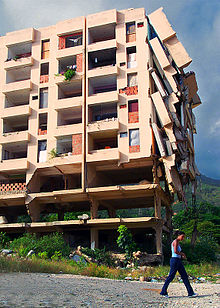Vargas tragedy
According to relief workers, the neighborhood of Los Corales was buried under 3 meters (9.8 ft) of mud and a high percentage of homes were simply swept into the ocean.[2] The unusually strong storm in December 1999 dumped 911 millimeters (35.9 in) of rain over just a few days, triggering widespread soil instability and flow of debris.The alluvial fans built as sediments from floods and debris flows exit their channels and meet the oceans provide the only extensive flat surfaces along the mountainous coastline of north-central Venezuela.From the coast and extending approximately 1 kilometer (0.62 mi) inland, deeply foliated schist of the Mesozoic Tacagua Formation is exposed.[2] The modern channel systems of these alluvial fan deltas are incised into previously deposited debris flow and flood material.These abandoned high surfaces suggest recent and continuing tectonic uplift of the Venezuelan coast and corresponding river channel incision.Starting around 8 PM local time (AST) on 15 December, runoff entered channels and rushed towards the sea, picking up and depositing sediments on its way.Generally after this first wave of flooding, from the coast to just past the crest of the Sierra de Avila, these rains triggered thousands[4] of shallow landslides that stripped soil and rock off the landscape and sent them slipping down the mountainside.Many catchments released multiple debris flows, some of which carried large boulders and tree trunks onto the alluvial fan deltas.These floodwaters were less concentrated in sediment and were therefore able to entrain new material and incise new channels into the flood and debris flow deposits from the previous days.Second, it lies at the mouth of the Quebrada San Julián (Saint Julian Ravine), and this watershed produced very large boulders and a massive inundated area.[2][3] The death toll was considered to be between 10,000[5] and 30,000[2]—the exact number of casualties is difficult to determine as there is no reliable census data from the region at that time, especially about shanty towns and small communities that were completely wiped out.Public services, like water, electricity, phone lines, and land transportation (roads and bridges) completely disappeared in some places.Then-First Lady Marisabel Rodríguez de Chávez arranged the temporary sheltering of children that were feared orphaned in La Casona, the Presidential residence in Caracas.[2] After the initial emergency response, focus shifted to analyzing the causes of the disaster, and working to create a sustainable infrastructure for dealing with future torrential rains.Chávez initially accepted assistance from anyone who offered, with the United States sending helicopters and dozens of soldiers that arrived two days after the disaster.[7]: 131 Despite initial dispersals of emergency funds, receiving tens of millions of dollars from international organizations and the announcement of reconstruction plans, little came of the process and Chávez grew distracted with political squabbles, abandoning attention on the tragedy with recovery ultimately halting.[5] Over a decade after the tragedy, thousands remained homeless and the value of real estate in zones untouched by the floods declined by as much as 70%, due to the destruction of infrastructure.He also received plaques and medals from private institutions and governments, international tributes and recognition by the Grand Lodge of Masonry in Venezuela.






Vargas StateVenezuelaCoordinatesflash floodsdebris flowsIsohyetalluvial fansSimón Bolívar International AirportMaiquetia, VenezuelaCaraballedaCaracasCerro El ÁvilabedrockmetamorphicfoliatedMesozoiccolluvialA horizongneissesPaleozoicPrecambrianfabricslandslidedippingbraided riverUS Geological Surveypaleosolsradiocarbon datedBefore PresentaggradedAlluvial fandeltasangle of reposeMorón Fault SystemTerracestectonic upliftfaultsQuaternarystrike-slipgranular flowsavulsedshanty townsmartial lawRed CrossHugo ChávezMarisabel Rodríguez de ChávezMajor League BaseballshortstopOmar VizquelNew MexicoJoseph CarraroUSS TortugaFidel Castroits medical internationalismChávez administration's foreign policyRottweilermudslidegastroenteritispoor cinema industryArmero tragedyUniversity of California PressYale University PressSt. Martin's PressarticlesHistoryNew GranadaCaptaincy GeneralWar of IndependenceGran ColombiareunificationRevolution of the ReformsFederal WarRevindicating Revolution1895 crisisRestorative Liberal Revolution1902–03 crisisWorld War IIEl Trienio Adeco1958 coup d'étatPuntofijo PactEl CarupanazoEl PorteñazoCaracazo1992 coup d'état attempts2002 coup d'état attempt2002–03 general strikeCrisis2017 constitutional crisis2019 presidential crisisCivil warsCoups d'étatGeographyBordersCitiesmetropolitan areasClimateEarthquakesEnvironmental issuesNational parksNatural RegionsPoliticsCorruption in VenezuelaTorture in VenezuelaHuman rights in VenezuelaCrisis in VenezuelaAdministrative divisionsRegionsStatesConstitutionElectionsForeign relationsLaw enforcementMilitaryMissionsNational AssemblyPresidentVice PresidentCabinetSupreme Tribunal of JusticeIn exileGuayana Esequiba (Reclamation area)PartiesGreat Patriotic PoleUnited Socialist PartyMovement We Are VenezuelaCommunist Party